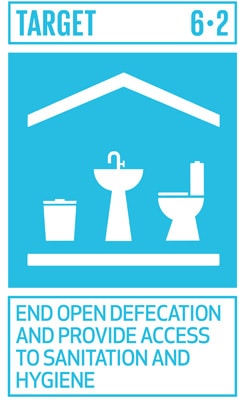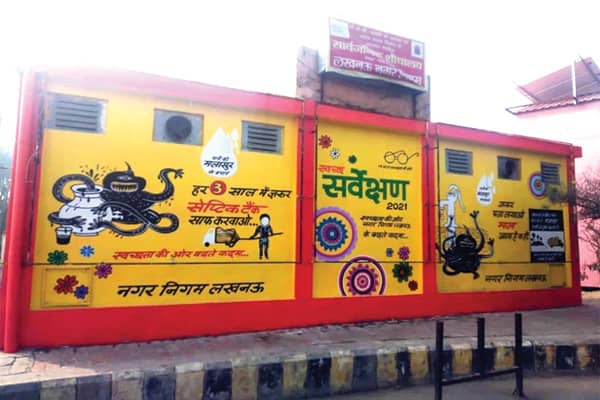
Water, Sanitation and Hygiene, inclusively known as WASH, is the principal aspect at community level, with respect to health, livelihood and economy. Functional WASH interventions thus play the role of predominant factor in SDG 6.2 under SDG 6, that focuses on Sanitation and Hygiene, writes Jheelam Sarkar, Program Officer (Technical), Sanitation Capacity Building Platform (SCBP), NIUA and Amita Pathria, Program Officer, SCBP, NIUA.
In spite of the initiatives being taken to eradicate the risks of unsanitary livelihood, India still has higher rates of stunting and wasting among children under five years of age, due to poor sanitation¹. Even though access to water has improved, access to sanitation is still on the verge of augmentation, with a coverage of 59.5 per cent². Though the circumstances are challenging, enumerating the challenges and devising proper strategies to overcome these would surely lead to successful achievement and safe sanitation for all by 2030.

SDG 6.2 states that access to adequate and equitable sanitation and hygiene for all needs to be achieved by 2030, putting an end to open defaecation and paying special attention to the needs of women and girls, and those in vulnerable situations.
There was a prodigious improvement seen in the statistics of Indian population defaecating in the open, and suffering from indignity, lack of access to toilets, from around 568 million to an estimated 450 million people; all in the account of Government’s flagship programme Swachh Bharat Mission (SBM) (Clean India Campaign); which now in its second phase of execution aims to extend the sustainable use of toilets and hygiene practices, besides proper waste (solid/liquid) management³.

Proper sanitation and hygiene implies to appropriate construction of toilets, safe management of human waste including safe confinement, treatment and disposal; availability of water, wastewater management, solid waste management, control of vector-borne diseases, and taking care of domestic and personal hygiene. While SBM Phase I accomplished its targets by subsidising construction of single/ twin pit toilets at household and community levels, in both rural (71.3 per cent access) and urban (96.2 per cent access) areas, and SBM Phase II is working on the sanitation chain, leading towards the objectives of SDG 6.2⁴, why is there a gap in provision of basic sanitation still pertaining?


The lack of basic sanitation is the result of the challenges that are being faced at every level with respect to awareness, behavioural change, and education. Rapid urbanisation initiates the emerging demand for sanitation, which would grow along, eventually by 2030.
Improving the toilet infrastructure cannot solely eradicate the faecal or oral transmission of pathogens. The technical and behavioural components conducting the gap, contributing to the need for behavioural change are:
● Lack of access to clean water and properly constructed sanitary toilets being a key issue⁵.
● Unavailability of basic amenities like soap, menstrual hygiene products for emergency and disposal bins (for women and girls) etc.
● Lack of ergonomic design of public/community toilets, as they might be used by people of all ages, men, women, the third gender, and people with disability, following gender disparity.
● Lack of proper containment and disposal without treatment is still a persisting issue, due to inappropriately engineered toilet outlets/septic tanks, leading to overflow of septic tanks.
● Disposal through open drains reflecting improper management of faecal waste.
● Inappropriate framework of toilets, with no access for the third gender, and inconsideration of individual attitude towards the use of toilets.
● Lack of sanitation facilities fabricating psychological stress among girls and women, due to environmental obstacles such as unsafe toilets, leading to fear of sexual violence and social factors⁶.

To understand these concerns from a layman’s perspective, involvement in sanitation programs, awareness creation, and involvement in various social movements are much needed. With the trend in change of traditional sanitation approach of centralised system to a safer system like Non-Sewered Sanitation (NSS) and Citywide Inclusive Sanitation (CWIS); that looks into core sanitation under the principle heads of safe, equitable, responsible, accountable and financially viable system with proper resource planning and management; the existing issues could be dealt with in a better way.
Talking about solutions, ULBs need to realise the urgency for continuous supply of water, parallelly with sanitation. Going ahead with the CWIS principles, firstly, for providing safe sanitation, responsibility should be taken into account for construction of technically designed toilets with containment systems following appropriate norms (IS 2470).
Secondly, in many cities dependent on on-site sanitation, sludge flows mostly through underground drainage system, followed by stormwater drains to open drains; which should be sermonised with the need for Sewage Treatment Plants/ Faecal Sludge Treatment Plants, along with understanding of the concept of drainage system.
To address these issues from the very core of the problem, first it has to be realised that sanitation is a public service. Keeping that in mind-
● The education system needs to include modules for decoding the link between sanitation, hygiene, health and economic development.
● Addressing gray and black water management within training courses would help to understand the concept of sanitation chain, as per the second phase of SBM.
● Creating work designations and encouraging more women centric jobs/positions in the sector would ensure security as well as gender equality.
● Socially recognising and providing sanitation workers with financial, health benefits and social security, to give them recognition at the ground level.
Such steps would surely emphasise Information Education and Communication (IEC) and Behaviour Change Communication (BCC), as they are the cue towards the shift in attitude and mentality among the municipal bodies and common people.
Even though some premiere institutions under the NFSSM Alliance are already moving forward with capacity building for a better understanding of entire sanitation progress, a chain of champions and change makers is much needed for training the trainers, government officials as well as the educators. Building capacity does not only signify gaining knowledge, but also working together as a community. Organising exhibitions, theatrics, nukkad nataks, hoardings, mobile messages, and wall paintings to disseminate awareness and education through IEC and BCC are also a part of capacity building. In the same context, social media and the digital world should be persuaded to bring these issues to the forefront through more movies like ‘Toilet’, series like ‘Panchayat’ and different articles on such varied topics.
As a part of contribution to social and behavioural communication, the Malasur campaign – demon of defaecation – was launched by the Ministry of Housing and Urban Affairs (MoHUA) for spreading awareness about the risk of the mismanagement of faecal sludge, leading to pollution of water, under IEC and BCC with various artworks representing Malasur which are used by the ULBs for conducting the campaigns at respective local levels.
Acknowledging the issues is not enough, unless solutions are followed accountably. Only then could the indicators for monitoring usage of improved and safe sanitation along with proper maintenance of hygiene, lead to the fulfillment of SDG 6.
1. Kedia, M, 2022. Sanitation policy in India–designed to fail?. Policy Design and Practice, pp.1-19.
2. Kanyagui, M.K. and Viswanathan, P.K., 2022. Water and sanitation services in India and Ghana: an assessment of implications for rural health and related SDGs. Water Policy.
3. Water, sanitation and hygiene, UNICEF
4. Sarkar, S.K. and Bharat, G.K., 2021. Achieving Sustainable Development Goals in water and sanitation sectors in India. Journal of Water, Sanitation and Hygiene for Development, 11(5), pp.693-705.
5. Behera, M.R., Pradhan, H.S., Behera, D., Jena, D. and Satpathy, S.K., 2021. Achievements and challenges of India’s sanitation campaign under clean India mission: A commentary. Journal of Education and Health Promotion, 10.
6. Sahoo, K.C., Hulland, K.R., Caruso, B.A., Swain, R., Freeman, M.C., Panigrahi, P. and Dreibelbis, R., 2015. Sanitation-related psychosocial stress: A grounded theory study of women across the life-course in Odisha, India. Social science & medicine, 139, pp.80-89.
Be a part of Elets Collaborative Initiatives. Join Us for Upcoming Events and explore business opportunities. Like us on Facebook , connect with us on LinkedIn and follow us on Twitter, Instagram.











